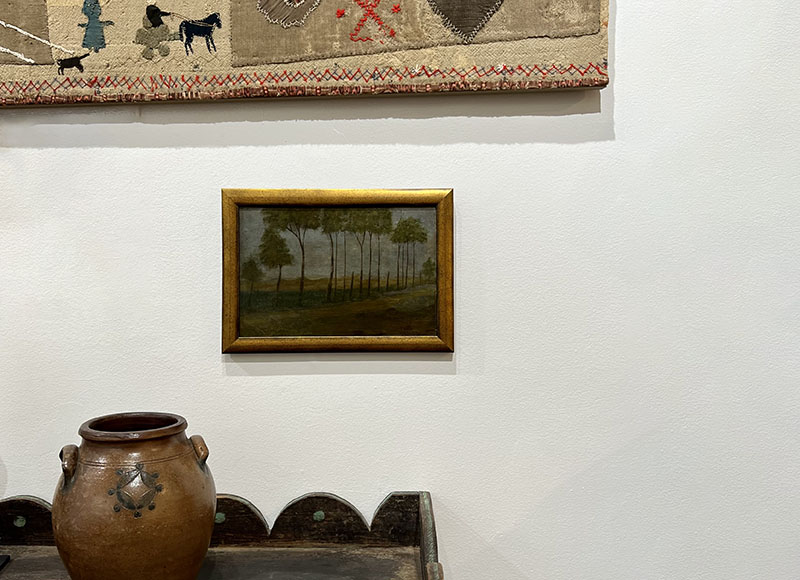- HOME
- INVENTORY
- GALLERY
- BOOKS
- CATALOGS
- ABOUT & MORE
- CONTACT
Contact Us
Night Trees
Emile Branchard (New York, 1881-1938)
Oil on artist board
Circa: 1925
Size: 8" x 11 1/2" (sight)
A sensitively painted small work with a very specific light quality to the early night sky.
Room 521 in the expanded and rehung Museum of Modern Art is dedicated to past director, Alfred H. Barr, Jr., and his groundbreaking exhibit of 1938, "Masters of Popular Painting." The show focused on self-taught and artists removed from the mainstream market or as they were called then, "folk artists, or naives," today we may term them as "outsiders." Emile Branchard was one of the artists represented in that seminal exhibit.
Branchard was born (1881) and raised on the streets of New York City and lived in a large rooming house that his mother ran on Washington Square South. At the age of thirty-seven, Emile Branchard, a former truck driver, longshoreman, and policeman, found himself with tuberculosis and was forced to retire. He set up a painting studio in the basement and created imagined landscapes. A border of the house who recognized Branchard's talent entered a few paintings, without his knowledge, to the Society of Independent Artists show of 1919. His works were accepted and influential gallerist, Stephen Bourgeois offered him a solo show later that same year (Bourgeois would then regularly exhibit his work until 1932).
Bourgeois remarked of Branchard's work at the Independent Show, "those two small paintings appeared as the best proof, that art is not a question of colouristic or formalistic ability or brush-acrobatics, but primarily a question of vision."
The progressive art cognoscenti of the 1920-30s advocated for artists on the margins—artists that didn't rely on painterly craft or apprenticeship to express what they saw and how they saw it. Holger Cahill wrote, "They are devoted to fact, as a thing to be known and respected, not necessarily as a thing to be imitated. Surface realism means nothing to these artists." Branchard himself stated, "I've never seen the ocean or spent a day out of New York. All art is a dream."
Branchard died in February of 1938, just months before the opening of the "Masters of Popular Painting" exhibit. In addition to the five works hung at MOMA, The Marie Harriman Gallery held a memorial exhibition later the same year.
The noted art dealer Sidney Janus included Branchard in his 1942 book, "They Taught Themselves." Janus recalls that when Branchard wanted to paint, he would set up a canvas and while doing house chores, he would pass the easel several times throughout the day—glancing at the blank canvas and then "all at once [see] a picture upon it, and put it down in paint."
In addition to Janus, other New York galleries such as Graham Gallery and the then young [Virginia] Zabriskie Gallery carried the torch for Branchard and continued to exhibit his work in the 50s-70s. Additionally, the art dealer and folk art advocate [Robert] Schoelkopf Gallery showed his work.
Branchard's work is held in several major museum collections including, MOMA, The Met, The Hirshhorn, The Philadelphia Museum of Art, Museum of Fine Arts Boston, and the Albright-Knox Museum.
Selected Bibliography: Harriman Marie, Memorial Exhibition, Emile Branchard. New York: Marie Harriman Gallery, 1938.
Zabriskie, Virginia, Emile Branchard : March 26th through April 14th 1962. New York: Zabriskie Gallery, 1962.
Bourgeois, Stephen, Exhibition of Painting and Drawings by Emile Branchard. New York: Bourgeois Galleries, 1919.
Janus, Sidney, They Taught Themselves : American Primitive Painters of the 20th century. New York: The Dial Press, 1942.
Cahill, Gauthier, Cassou, & Miller, Masters of Popular Painting, Modern Primitives of Europe and America. New York: The Museum of Modern Art, 1938.
Hemphill and Weissman, Twentieth-century American folk art and artists. New York: E.P. Dutton, 1974.
HIGH RESOLUTION IMAGES AVAILABLE.
Condition: Excellent with scattered in-painting throught.
Price: $4,400.00

ALL ITEMS GUARANTEED AS REPRESENTED
STEVEN S. POWERS • 53 STANTON ST, NY, NY 10002 • 917-518-0809 • email: steve@stevenspowers.com • © all rights reserved


